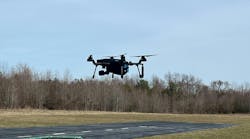Last year when Assistant Chief Steven Casstevens arrived at the scene of a traffic crash a couple blocks from the Hoffman Estates (Illinois) Police Department, he found a woman standing beside a totaled car. Casstevens assumed she was a witness, but she was the driver and didn't have a scratch on her.
"I said, 'Clearly you must have been wearing your seat belt,' " he recalls. "She reached into her purse and pulled out a seat belt ticket that one of my officers had given her two days prior. She said, 'I got this ticket from one of your officers during one of your Click It or Ticket campaigns. That's the only reason I wore my seat belt today.' "
With seat belt education and law enforcement, individual officers on the street can make a difference.
"It's the ultimate in helping people," says Bob Wall, International Association of Chiefs of Police (IACP) National Law Enforcement Challenge coordinator.
Looking at nationwide statistics, he points out 420,000 people a year are killed on U.S. highways, and failure to use a seat belt is still one of the No. 1 reasons people are dying.
Overall, about 19 percent of the American public is still not buckling up since seat belts were made standard in the 1960s, according to the National Highway Traffic Safety Administration's (NHTSA's) National Occupant Protection Use Survey (NOPUS) 2006 data.
Among specific populations, the percentage of people not buckling up is higher. According to NHTSA, of the 21 to 24 year olds killed in 2005 crashes, 65 percent were not wearing seat belts, and 66 percent of 25 to 34 year olds were not wearing seat belts.
The number of people buckling up has been increasing slowly and steadily in recent years. In the last 10 years, from 1996 to 2006, the increase in seat belt use was dramatic, up 20 percent from 61 percent in 1996, according to NOPUS data.
"We are just now reaching the higher risk population," says Janet Dewey-Kollen, program manager (Bency & Associates consultant) with the New Mexico Department of Transportation. "They are more risk-tolerant. Not only do they not put their seat belts on, they typically don't make sure the children in their vehicle are buckled up. They tend to drive more aggressively, speed and drink and drive. Overall, they tend to have more crashes."
Every percentage point increase would save 278 more lives, according to a NHTSA spokeswoman. That number is based on NHTSA estimating an additional 5,328 lives would have been saved if everyone over 4 years old had been wearing belts instead of 82 percent wearing seat belts in 2005.
By prioritizing seat belt education and enforcement, and targeting populations that are less likely to wear seat belts, such as nighttime drivers and teens, law enforcement agencies can make a difference not only in their communities but across the nation.
The highest seat belt use ever
The highest seat belt use to date, 96.3 percent, was achieved by Washington state, according to a NHTSA observational survey done in June 2006.
What led to this success?
Jonna VanDyk, Washington Traffic Safety Commission (WTSC) occupant protection program manager, lists a few reasons in addition to the state's primary enforcement seat belt law:
- Law enforcement at all levels are willing to educate motorists and ticket them for not wearing seat belts.
- Aggressive media campaigns accompany law enforcement patrols.
- 636 road signs throughout the state remind motorists to buckle up or receive a $124 fine (as of July 1, 2007, up from $101) if they don't.
"Washington law enforcement are, by and large, aggressive in their enforcement of the seat belt and child car seat laws," VanDyk says.
Nighttime enforcement
In late May and early June, WTSC, which has twice won the Peter K. O'Rourke Special Achievement Award from the Governors Highway Safety Association, conducted its first nighttime seat belt enforcement project. Looking at 2005 through 2006, most seat belt tickets were written during the day, with only 15 percent at night.
"We moved our seat belt patrols to take place during the hours of darkness because our traffic death rate at night is four times what it is during the day," explains VanDyk. "As you can imagine, seeing unbuckled motorists at night is a challenge."
But the Washington State Patrol, along with other agencies, figured out a way to do it. Their enforcement model is described in an educational video available at www.wtsc.wa.gov. Stationary patrols utilize several officers. An "observing" officer is positioned where ambient lighting is good. That officer watches traffic and looks for unbuckled motorists. When he spots some-one who is unbuckled, he radios officers to make the stop.
Comments from the 80 police and sheriffs agencies and the Washington State Patrol, all participating in the first nighttime campaign, were generally favorable.
"Some struggled with ambient lighting," VanDyk adds. "It may have been there, but wasn't in the right location to facilitate looking into cars. For others, illegally tinted windows were a concern."
Overall, Washington law enforcement intercepted a large number of high-risk behaviors. As a result of the campaign, there were 4,671 seat belt and car seat violations, 144 drunk driver arrests, 115 drug arrests, 176 reckless or aggressive driving violations and 169 other criminal arrests. In addition, 39 felons were taken to jail and eight stolen cars were recovered. Sustained efforts continued during the summer and another big campaign is scheduled to run for about two weeks near Halloween.
Funding for the project comes from WTSC with a grant from NHTSA.
Through research accompanying the project, it's hoped more can be learned about the driving and criminal histories of people who drive unbuckled at night.
VanDyk encourages law enforcement to focus on nighttime seat belt law violators. As a result, she says, "Law enforcement will intercept a lot of the kinds of miscreants that cause serious injury and fatal collisions and other social problems. The project also might engender camaraderie among the officers, and, if multi-jurisdictional, among agencies. They might find that communication problems exist when trying to work on a project with numerous agencies. This will give them an opportunity to work out such issues and be better prepared to respond in a major crisis."
Talking to teens
Hoffman Estates has received numerous awards for its traffic safety programs, realizing teens don't always think wearing seat belts is cool.
According to the Centers for Disease Control and Prevention, motor vehicle crashes are the leading cause of death for U.S. teens, accounting for 36 percent of all deaths in this age group. One of the risk factors for this age group is not wearing seat belts. Compared with other age groups, teens have the lowest rate of seat belt use. In 2005, 10 percent of high school students reported rarely or never wearing seat belts when riding with someone else. African-American students (13.4 percent) and Hispanic students (10.6 percent) were more likely than white students (9.4 percent) to rarely or never wear seat belts. Male high school students (12.5 percent) were more likely than female students (7.8 percent) to rarely or never wear seat belts.
In partnership with the Illinois State Police and a local Saturn dealership, the Hoffman Estates Police Department twice a year offers driver's education students programs that tell them why it's smart to wear seat belts and drive safe. Students learn how seat belts and air bags work, how they're designed to deploy in a crash, and more.
Challenges for law enforcement
Getting people to buckle up is especially challenging for law enforcement officers when states do not have primary safety belt enforcement laws, says Phil Haseltine, Automotive Coalition for Traffic Safety president.
"It's as if they have one hand tied behind their back," he adds.
Looking at the 2006 NHTSA occupation protection use statistics, Haseltine points out belt use in states with secondary enforcement was 74 percent versus 85 percent in states where officers can pull over drivers specifically because they were not wearing a seat belt. Today only 26 states and the District of Columbia have primary safety belt laws.
Before Illinois passed a primary seat belt law in 2003, Hoffman Estates created an ordinance allowing village officers to issue a seat belt ticket on a separate citation. As a result, Hoffman Estates officers went from issuing about 600 seat belt tickets to about 6,000 annually.
Even when states have primary enforcement laws, Haseltine points out fines are generally lower than they are for comparable traffic offenses. Only Washington, D.C., and New Mexico give demerit points on a driver's license for violating a seat belt law, he highlights.
"That sends a message to citizens that this law isn't all that important in the eyes of legislators, and that makes the law enforcement officer's job more difficult," Haseltine says. "In a perfect world, the seat belt law would have penalties comparable to running a red light or going 10 miles per hour over the speed limit."
In jurisdictions where seat belt use is greater than 90 percent, on the West Coast for example, there are comparatively high fine levels, about $100, though Haseltine adds research hasn't yet quantified how much high fines contribute to higher seat belt use.
Click It or Ticket
Even though seat belt laws often are weak, enforcing them is important, he says. Haseltine points out law enforcement does particularly well stepping up their efforts to enforce seat belt laws and child restraint laws with Memorial Day mobilizations accompanied by local, state and national paid advertising.
"Clearly those mobilizations have helped increase belt use, and those mobilizations don't work without the wonderful cooperation of law enforcement," he says.
Last year the seven principal leaders of the National Safety Council's Air Bag and Seat Belt Safety Campaign, which is known for its Click It or Ticket mobilizations, were awarded a Flame of Life Award from the National Safety Council. Haseltine and Dewey-Kollen were among the leaders.
Today Click It or Ticket involves more than 12,500 agencies. Participating in the national campaign is not mandatory for law enforcement, but Dewey-Kollen, the first executive director of the campaign, suggests local agencies work smart and take advantage of the momentum that's built around the national mobilization.
"When a person hears on TV that the local police are out enforcing seat belt laws and they see someone pulled over at the side of the road, that person thinks 'I better wear a seat belt, because I don't want to get a ticket,' " she says.
Dewey-Kollen encourages local law enforcement to always be in touch with their state highway safety office and take advantage of the resources they offer.
Lead by example
While officers may be promoting Click It or Ticket, Wall says officers themselves are not always buckling up. (See "Click It To Ride" in the April issue of Law Enforcement Technology.)
"We have to help ourselves, too," he says.
When officers wear seat belts, they're also leading the public by example.
Dewey-Kollen says officers need to let fact override emotion. "Given that crashes are a leading cause of death and injury to officers, seat belts probably save more lives than Kevlar vests," she says.
Looking over a long period of time at fatal crashes, Haseltine says, "We know seat belts are about 50 percent effective in reducing your chances at being killed in a crash."
But, depending on the kind of crash and type of vehicle, seat belt effectiveness varies greatly. It's in some types of crashes, particularly rollover crashes, that seat belts are extremely effective.
Why seat belts are effective
Seat belts are effective because they keep drivers and passengers in their vehicles.
"Being in a vehicle crash, there's a built-in roll cage, a lot of structure around you," Haseltine explains. "The interior of a vehicle is a far more forgiving environment than being ejected outside of the vehicle. When you are ejected from a vehicle in a crash, generally bad things happen."
Another reason for wearing seat belts, he says, is that it maximizes the benefits derived from other safety systems in the vehicle.
He gives an example: "A belted person is going to be in the correct position when the air bag deploys and receive the maximum benefits of the air bag.
"If vehicle engineers could rely on motor vehicle occupants being belted, the engineers could design air bag systems and other systems that would be more effective."
Lastly, seat belts help drivers keep control of their vehicles in a crash, Haseltine says. "In a lot of crashes, the vehicle is still moving. There's a certain degree of control that perhaps can be exercised by the driver if the driver is sitting in the driving position with his hands on the wheel and seated in a position where he can get at the pedals."
One hundred percent?
Despite all best efforts, will there be a day when everyone wears a seat belt?
"Probably not," Haseltine says, noting that so far, no one has been able to achieve and maintain higher than about 96 percent.
"As a nation, moving from 81 to 96 percent, will realize a huge reduction in fatalities and serious injuries. But, I think we will always have 3 or 4 or 5 percent who are not restrained -- people who are adamant or part-time users, who buckle up when they think they are most at risk."
Yet, law enforcement must continue making a difference because the risk is always there.
Commercial motor vehicle drivers
Another population that's less likely to buckle up is commercial motor vehicle drivers.
In 2003, the Department of Transportation found that only 48 percent of commercial motor vehicle (CMV) drivers wore their safety belt. As a result, the Secretary of Transportation created the CMV Safety Belt Partnership to address the problem and get the word out to drivers that they need to buckle up. Since then, safety belt use has increased to 59 percent (as of 2006).
"We still have much work to do," says Janet Kumer, Commercial Motor Vehicle Driver Safety Belt Program manager for the Federal Motor Carrier Safety Administration and coordinator of the CMV Safety Belt Partnership.
The "Be Ready. Be Buckled." campaign appeals to the truck driver's professionalism. To find out more, see www.fmcsa.dot.gov/safetybelt.
Buckling up employees
Not only are traffic crashes the leading cause of death in the workplace and a leading cause of work-related disabilities (Bureau of Labor Statistics, 2001), they also lead to economic costs such as lost productivity, workers compensation and medical costs, and higher insurance premiums.
Buckle Up Employees: A Network of Employers for Traffic Safety (NETS) Corporate Seat Belt Program includes seat belt policies, daily campaign messages and activities, a newsletter article, a poster, paycheck stuffers, strategies to incentivize belt use, instructions for conducting an on-site observational survey to determine an organization's use rate, and more. See www.trafficsafety.org/buckle.asp.
Law enforcement agencies can benefit by becoming a NETS member and by promoting NETS and its resources.
Child restraints save lives
When talking about seat belts, it's important to note that motor vehicle-related injuries kill more children and young adults, ages 1 to 34, than any other single cause in the United States, according to the Centers for Disease Control and Prevention (CDC).
Each day about four children ages 14 years or younger die and about 556 are injured in motor vehicle crashes, according to the National Highway Traffic Safety Administration (NHTSA) Traffic Safety Facts. In 2005, the number of children who died totaled 1,451 children.
The CDC says many deaths can be prevented by placing children in age- and size-appropriate restraint systems, which reduces serious and fatal injuries by more than half. Of the children ages 0 to 14 years, who were killed in motor vehicle crashes during 2005, nearly half were unrestrained.
Whether or not a child is restrained often depends on whether or not the driver is restrained. Almost 40 percent of children riding with unbelted drivers were themselves unrestrained, according to a national study of restraint use (National SAFE KIDS Campaign, 2002).
Rebecca Kanable is a freelance writer and editor specializing in law enforcement topics. She can be reached at [email protected].


